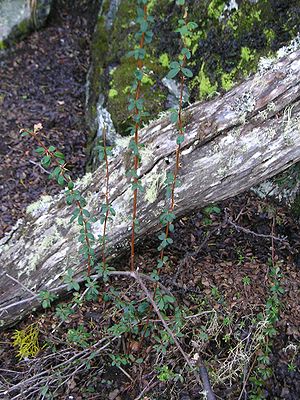Box-leaved barberry
| Box-leaved barberry | ||||||||||||
|---|---|---|---|---|---|---|---|---|---|---|---|---|

Box-leaved barberry, Tierra del Fuego National Park, Argentina |
||||||||||||
| Systematics | ||||||||||||
|
||||||||||||
| Scientific name | ||||||||||||
| Berberis microphylla | ||||||||||||
| G. Forest. |
The box-leaved barberry ( Berberis microphylla , Syn . : Berberis buxifolia Lam. Ex Poir. ) Is a shrub with beech- like leaves. It belongs to the barberry family (Berberidaceae). This plant species was described by Johann Georg Adam Forster in 1787 .
description
The evergreen shrub reaches heights of growth of up to 3 m. Young twigs are covered with fine hair, older twigs are bare. The bark of the branches is light brown, yellowish or gray and has longitudinal cracks and numerous black spots; in old age the bark can be fibrous to flaky. The numerous thorns are in three parts, the thorn branches are 3 to 45 mm long.
The leathery, box- like leaves are ovate to ovate-lanceolate, rarely elliptical or simply elongated; they are 6 to 40 mm long and 2 to 14 mm wide. The leaf is stalked 1.5 to 5 mm long, prickly, with entire margins or with 1 to 2 protruding thorn-pointed teeth on each side. The attachment point of the leaf sometimes remains as a small stump after the leaf has fallen.
The inflorescence is a single flower (rarely an umbel consisting of 1 to 3 flowers ). The flower stalks are 5 to 24 mm long, the individual flowers are yellow to orange-yellow, 4 to 5 mm long and contain 12 to 15 tepals . The spherical black and blue berries have a diameter of 7 to 11 mm, the 1 to 10 seeds are 4 to 6 mm long and black to brown.
The box-leaved barberry blooms in southern South America from August to March (with an emphasis from October to January) and is mainly fruiting from December to March.
The number of chromosomes is 2n = 56, less often 28.
distribution
The box-leaved barberry, which is called michai , mulun or calafate in its homeland , is distributed from the Región del Libertador General Bernardo O'Higgins in central Chile at 2500 m asl to Tierra del Fuego in the south of Argentina and Chile, where it occurs at sea level . It is said to be a symbol for Patagonia ; Legend has it that anyone who eats berries from this shrub will definitely return to Patagonia. Berberis microphylla benefits from interventions in nature and grows particularly well in disturbed locations and also along roads.
use
The box-leaved barberry is grown commercially for its fruits and can be used to make jams . It is also said to have healing properties. It is also planted as a garden plant or bonsai , also as an alternative or replacement for boxwood endangered by the box tree moth . The wood is used to make red dye .
Cultivated forms
- Berberis buxifolia 'Nana' (Syn .: Berberis dulcis Sweet var.nana Carr. ): This variety has been in cultivation since 1867. It is used as a ground cover in gardening and landscaping. The plants are slow-growing, only up to 0.5 m high and 0.8 m wide; they have (almost) no thorns and rarely or not at all bloom.
- The hybrid Berberis × antoniana Ahrendt ( B. buxifolia × B. darwinii ) was bred in Northern Ireland; it grows as a small, compact shrub.
- Natural hybrids with Berberis valdiviana and Berberis trigona are known.
Synonyms
Berberis microphylla is a very variable species, which is why there are many synonyms. The most common is certainly Berberis buxifolia . This name was described by Lamarck in 1792 , five years after the description of Forster's Berberis microphylla was published, which is why the name Berberis microphylla is preferred.
- Berberis inermis Pers.
- Berberis heterophylla Juss. ex Poir.
- Berberis cuneata DC.
- Berberis dulcis Sweet.
- Berberis marginata Gay
- Berberis buxifolia var. Spinosissima rich
- Berberis spinosissima (rich) Ahrendt
- Berberis heterophylla var. Pluriflora Rich
- Berberis buxifolia var. Gracilior Albov
- Berberis buxifolia var. Papillosa C.K. Schneid.
- Berberis buxifolia var. Nuda C.K. Schneid.
- Berberis buxifolia var. Antarctica C.K. Schneid.
- Berberis antucoana C.K. cutting .
- Berberis buxifolia var. Antucoana (CKSchneid.) Orsi
- Berberis parodii Job
- Berberis michay job
- Berberis barilochensis job
Web links
- Berberis microphylla on www.chileflora.com
- Berberis microphylla on www.florachilena.cl (span.)
- Photo of the species from the botanical garden of the Ruhr-UNI Bochum ( Memento from June 4, 2008 in the Internet Archive )
Individual evidence
- ↑ Berberis buxifolia at Tropicos.org. In: IPCN Chromosome Reports . Missouri Botanical Garden, St. Louis
swell
- Leslie R. Landrum: Revision of Berberis (Berberidaceae) in Chile and Adjacent Southern Argentina . In: Annals of the Missouri Botanical Garden . 86, No. 4, 1999
- Jost Fitschen : Woody flora , arr. By Franz H. Meyer, 11. Erw. and corrected edition, Wiebelsheim, Quelle and Meyer, 2002, ISBN 3-494-01268-7
- Robert Zander : Zander. Concise dictionary of plant names. Edited by Walter Erhardt , Erich Götz, Nils Bödeker, Siegmund Seybold . 16th edition. Eugen Ulmer, Stuttgart 2000, ISBN 3-8001-5080-8 .
- The Hillier Trees & Shrubs, ed. by John Kelly and John Hillier, 1st ed., Braunschweig, Thalacker-Medien, 1997, ISBN 3-87815-086-5